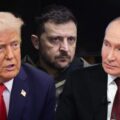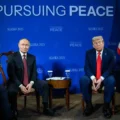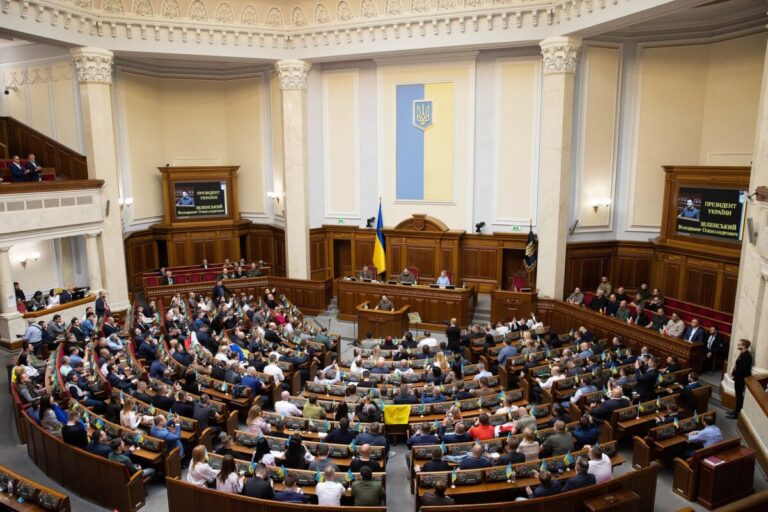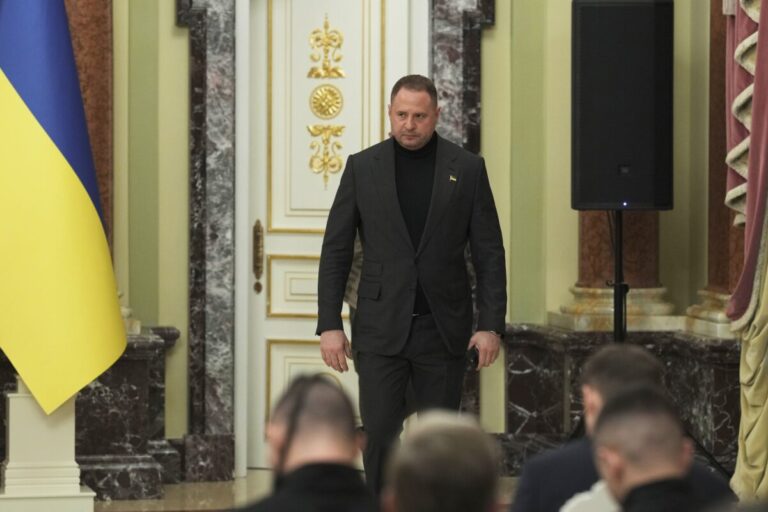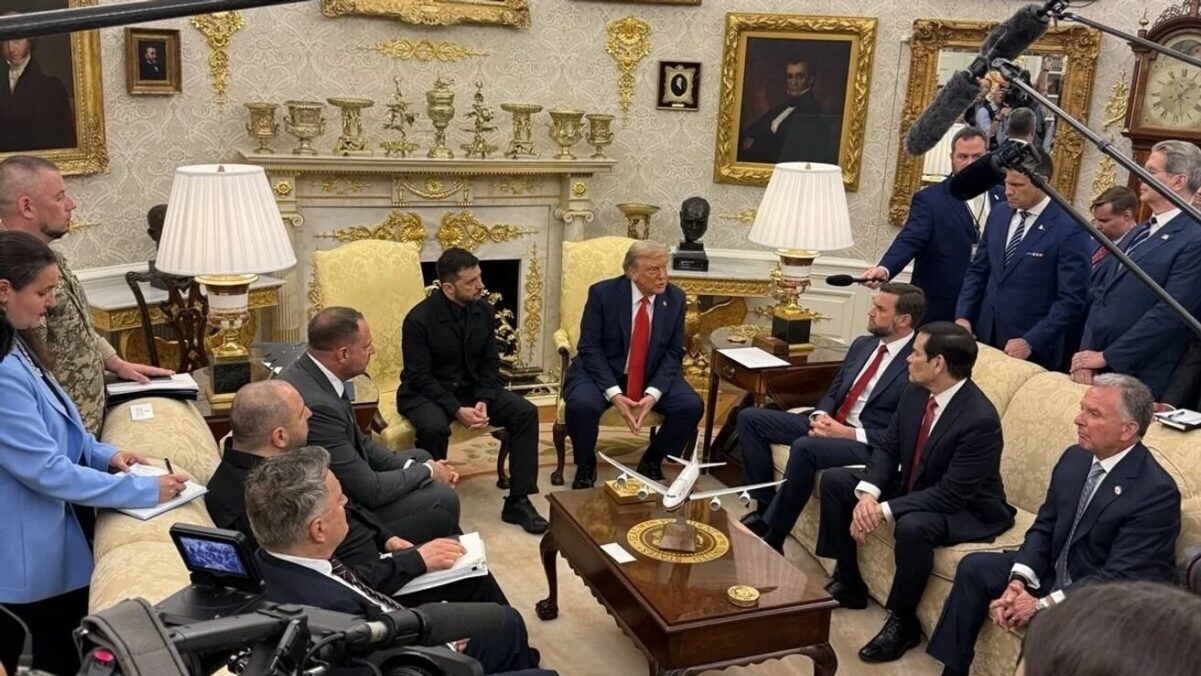
The Oval Office Map: how the Washington round laid bare the fault lines and the bounds of a possible deal
The key scene unfolded even before the main discussion began: the Oval Office displayed a large map of Ukraine with shaded Russian-occupied territories. According to BBC correspondent Anthony Zurcher, it was placed by the Resolute Desk, facing the presidents. The country’s east was marked in pink as areas under Russian control, roughly 20% of the territory. Ukraine’s president responded immediately and publicly: “I discussed many details from the battlefield with President Trump. By the way, thank you for the map. A good map, great. I would even take it with me.” A piece of atlas props turned into a negotiating frame: what can be treated as a subject of trade, and what should be off the table.
For part of the American team, the map served as visual argumentation: where the war is ongoing and where it could be “stopped” by political decision. Reporters working in the White House suggested that such an exhibit gives the U.S. president a leverage tool on Kyiv around a “territory for peace” model. It is not a verdict on any deal, but a clear signal: Washington expects answers not only on security guarantees, but also on the geography of peace.
Divergent approaches: ceasefire first or a “deal right away”
The Washington events exposed a central tactical dilemma. The U.S. president, who recently spoke with Vladimir Putin, publicly pushed aside a ceasefire as a precondition for political talks and said he is moving “directly to a peace deal.” In the same logic came the line about priorities: “Number one is lives, and number two is everything else.” European states replied with a synchronized line: first a ceasefire, then negotiations.
The European Commission president Ursula von der Leyen set out the EU’s principles with precision: “On any territorial questions in Ukraine, our position is clear: international borders cannot be changed by force. These are decisions that Ukraine has to make, and only Ukraine, and these decisions cannot be taken without Ukraine.” She also stressed the substance of step one: “I think the terminology is not important… The result has to be the stopping of killings… Stopping killings is point number one.”
German chancellor Friedrich Merz was even more explicit at the table: “I cannot imagine that the next meeting will take place without a ceasefire. So let’s work on this and put pressure on Russia.” For Paris and Berlin, a ceasefire is an indicator of Moscow’s good faith. Without it, any “deal” risks becoming a canopy for continuing the war.
The Kremlin call during the meeting: a symptom of political asymmetry
Momentum was added by an episode in which the U.S. president interrupted a meeting with European leaders to call Vladimir Putin. Formally, the White House discussion resumed, but the gesture highlighted a format asymmetry: Moscow gained a direct channel at a key moment, while allies were trying to align a common position among themselves.
For Kyiv, that means less predictability. If Washington prefers a “deal right away”, while Europe insists on a ceasefireand verifiable guarantees, Moscow can try to play tactical pauses while maintaining pressure at the front.
Ukraine’s frame: security guarantees must work “like Article 5,” and border decisions belong only to Ukraine
Kyiv’s message was unambiguous. President Volodymyr Zelenskyy outlined two central blocks: “The first is security guarantees” and the search for a real mechanism to end the war. Sensitive topics, including any territorial questions, were placed at the leaders’ level. Ukraine’s logic is straightforward: a security guarantee must be operational, not declarative, like Article 5 of the North Atlantic Treaty, where an attack on one triggers a response by all.
The same principle was reaffirmed by Ursula von der Leyen, who added there should be no limitations for the Ukrainian Armed Forces or for the assistance partners provide. A separate signal from Brussels is a new, 19th package of sanctions against Russia planned for early September. That is the economic backbone of any political track.
A trilateral track and prisoner exchanges: what could actually move
Amid arguments about sequence, leaders floated more concrete ideas: a trilateral meeting with the U.S., Ukraine, and Russia, and humanitarian packages, including large prisoner exchanges. Here, Washington and Europe have consensus: humanitarian steps can and should be implemented immediately, without political add-ons.
Without a verified pause on the front and enforceable monitoring, political promises turn into paper. That is why Europe’s insistence on a ceasefire as step one is not bureaucratic ritual, but a mechanism against blackmail. If the shooting does not stop, negotiations become a continuation of war by other means. A second systemic risk is conceptual blur: when “peace deal” is used without clear boundaries and guarantees, the aggressor gains room to maneuver.
What comes next: a concrete agenda for allies
To avoid diplomatic asymmetry, partners should narrow the space for competing interpretations and publicly anchor a few points that are obvious to Kyiv and most European capitals:
- Ceasefire as the starting step: verified, with violation monitoring and automatic consequences.
- Security guarantees: not a formula of good intentions, but an operational instrument that works like Article 5, with clear responsibilities.
- Territorial integrity: no decisions without Ukraine, no border changes by force.
- Sanctions pressure: the 19th package as a signal of resolve and a platform for further measures.
- Humanitarian track: large prisoner exchanges and civilian protection as a parallel process, independent of political pauses.
The map in the Oval Office served as a detonator for debate. It forced every participant to name what real security for Ukraine means, where the red lines are, and whether allies are ready to synchronize the pace and sequence of steps. Answers to those questions will determine not only the dates of the next meetings, but the quality of the peace offered to Ukrainians. The rule here is simple: when boundaries are defined by law and guarantees are backed by force, maps measure not concessions, but responsibility.




